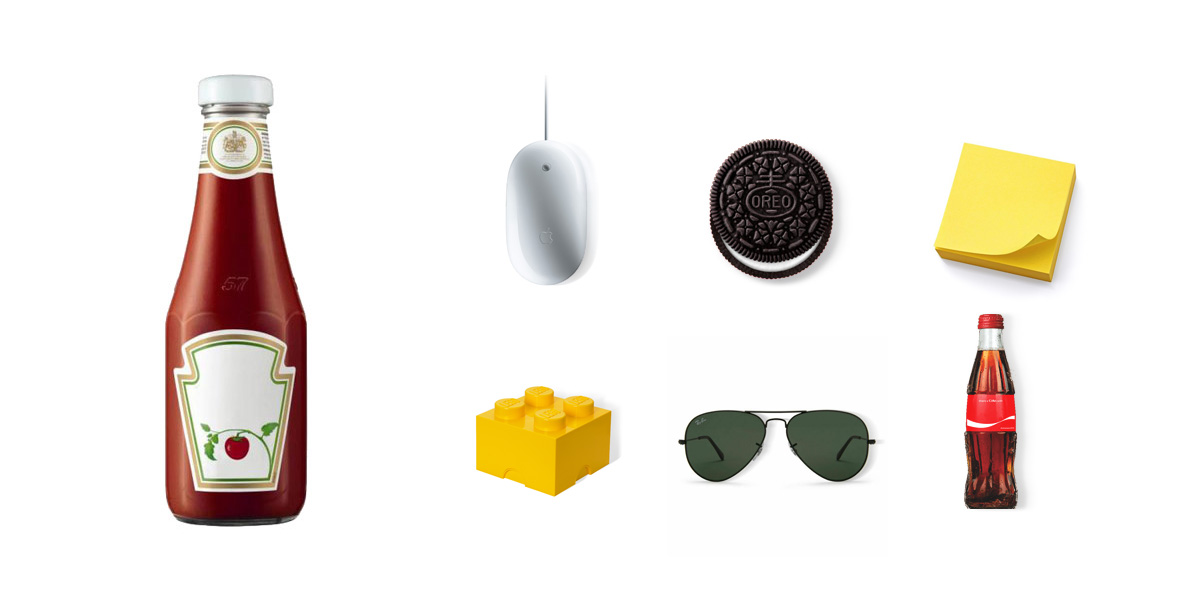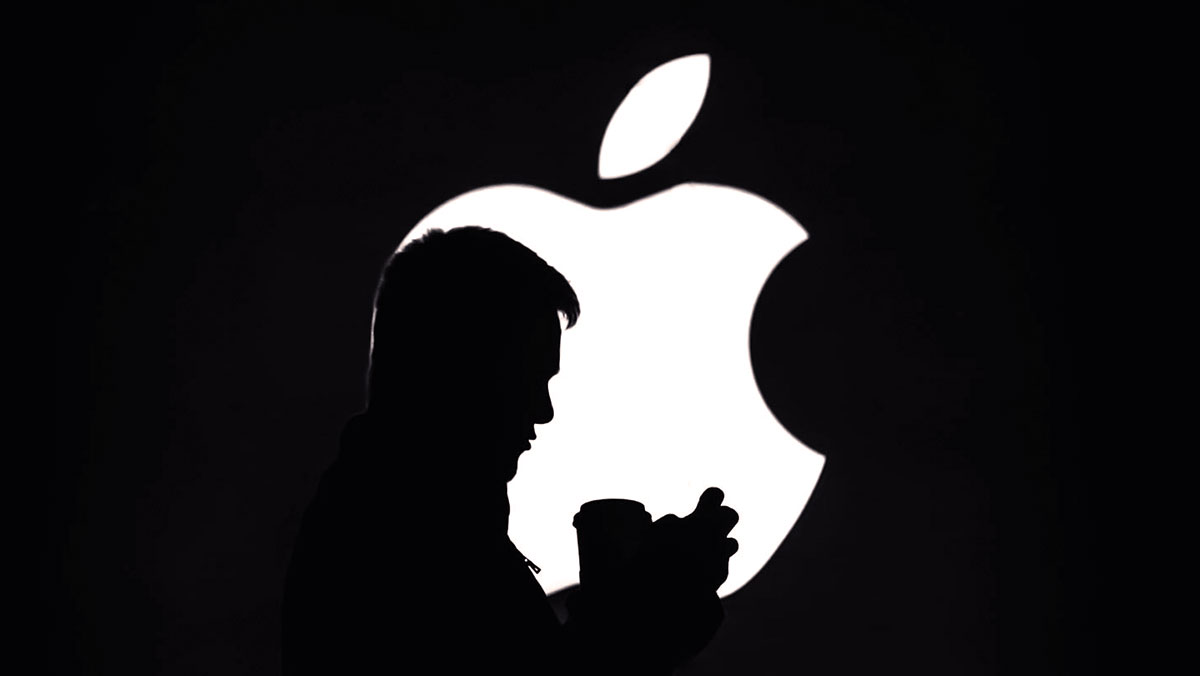
Brands larger than the names on their packaging.
Remember the Heinz bottles without the logo? This was a limited series from 2013 for the London store Selfridges, where famous brands such as Heinz, Marmite, and Levi’s presented their products without a brand name on the packaging. The customers did not have any difficulty with shopping. In fact, Selfridges’ action was a successful marketing move that caught the attention of the media and consumers.
Look at the “no-logo” products from this perspective – in the UK, every minute, a new company is registered, in the US, two startups are registered per minute, and in China, seven. We live in the era of globalization and hyper-competition. In every market and in every industry, there are hundreds, sometimes thousands of competitive offers that spend fortunes on promotion. And, at the same time, there are businesses that don’t even need a logo on the packaging to recognize and buy them. Such brands have become part of our general knowledge, part of our culture, habits, and our way of life.
The Heinz ketchup, the Oreo cookie, the Lego brick, the Coke bottle with its shape, the Apple Magic one-button mouse… These are representatives of brands with a power that exceeds their logo and advertising. The product itself embodies both the brand idea and the storytelling of the brand. It is a medium in itself, attracts attention, and creates a desire to own it.
Welcome to the world of absolute marketing
This is a world of brands that are more than just a business with a large market share and advertising budget. We don’t have to look around much to find them, we can easily recognize the “absolute brands”. Each of these brands has created a category in the industry to which it belongs – its own niche. Think about it: In the toys industry, among all dolls, cars, and teddy bears, Lego occupies its unique niche, and in this niche, they are without competition. Oreo is different from all other cookies, in fact, it is two cookies with a filling in the middle, and only Oreo can be eaten with the famous “twist, lick, and dunk”. Coke created its own category in the soft drink industry and Apple built it in the world of technology. What is your phone – Apple or Android? Have you ever thought, there are only two kinds of phones in the world? One is Apple and the other is Android, which is all other brands.
There are no longer two opposing sides – buyers versus sellers, manufacturers versus consumers, offerors versus receivers. The relationship is already a partnership.
The second sign of absolute brands is that they seem to be designed to exist in the long run. Of the companies mentioned above, Apple is 44, Lego is 89, Oreo is 109, and Heinz is over 150 years old. While these businesses have been developing, the world has not stopped moving, technologies, consumer needs and habits, cultures have changed. Many companies with short-term performance focus have failed to move at this pace and have disappeared. However, absolute brands are sensitive to changes around them and are tolerant of new ideas. This allows them to integrate their ID into the changing world and move forward.
And now, the most important thing. Look at the absolute brands – those that have become part of our general knowledge, part of our culture, and our way of life. Soon, all brands will become such. Either that or they will become products with no name. The move is required by the coming market reality.
We are witnessing the most profound changes in the social and economic order since the industrial revolution. New rules are being created in the market, and they are the ultimate challenge for most companies. Business tools that worked until yesterday are now obsolete. The product life cycle is shorter than ever. Whole product categories, which were necessary yesterday, are now forgotten. For example, when was the last time you bought a flash drive? Skyrocket-businesses crash overnight. See Netflix – in the collapse in 2019, they lost the partnership of film studios, blockbuster movies, and TV shows, and lost 25% of their subscribers in 24 hours.
It is clear that the market is being reformatted. There are no longer two opposing sides – buyers versus sellers, manufacturers versus consumers, offerors versus receivers. The relationship is already a partnership. People are a real force that is changing the market. From owners of buying power, just wallet owners with which they can buy or not, people become owners of information, they become media, critics, or defenders of brands. New economies are emerging in which partnerships with people are at the heart of the business model. Just look at eBay, Uber, Airbnb, and Kickstarter, to name a few. There are shared-economy alternatives to the banking system. Check out Lending Club and Prosper. And what about the employee-ownership model?
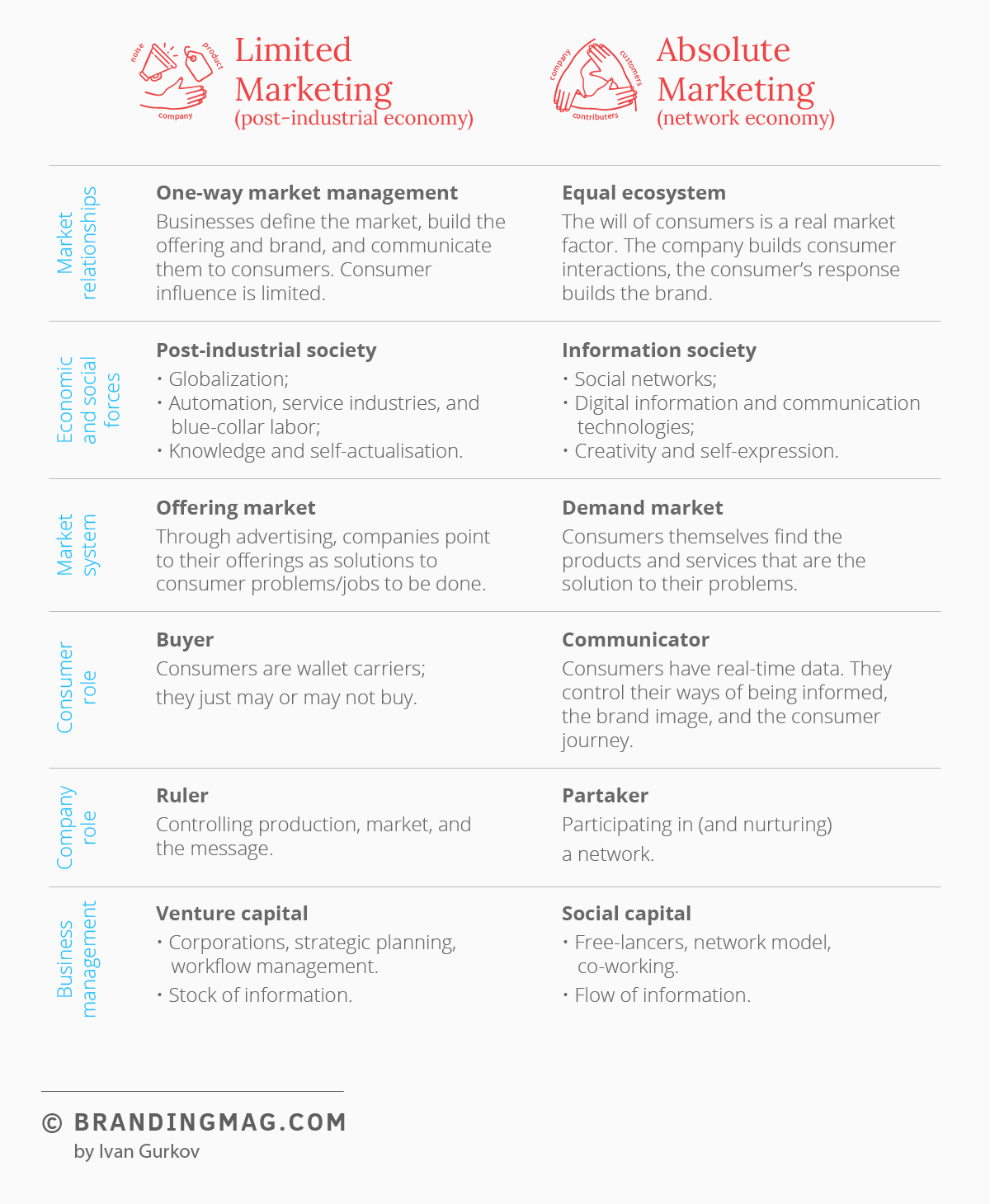
The market from businesses’ profit machine becomes an ecosystem in which the stakeholders – businesses, society, and the individual are on an equal footing and dependent on each other. This is a whole new world of absolute networking and absolute marketing relationships. Companies that want to move forward must build their place in this world.
Branding on a new principle – the two pillars of absolute marketing
Among all the turnovers around, businesses have one foothold that does not change over time. It is to be true to your brand.
Businesses that focus entirely on their operational goals allow day-to-day tasks to manage their vision. When you have a clear focus on your brand, your vision manages everyday tasks.
Some people here may be wondering, “Well, isn’t the brand just an image? How come it is the foothold of the business?”
The brand is not an image, it is a functional part of business management. A strong brand does two things: unlocks the potential of the business, and delivers it to people.
1. Business potential
The absolute brand starts with a clear definition of the business potential.
- How does your business bring change?
- What’s in your offering that people should care about?
- How your business will have the greatest impact on the category, on the industry, on the consumer experience, on society?
Remember – the good ideas are the crazy ones, until they’re not.
How about soup without water? It sounded crazy…until 1897, when John Dorrance came up with a radical idea to eliminate the water from the soup can, and that’s how the famous Campbell’s Condensed Tomato Soup was invented. How has this fact changed things? You see, the problem with soups is that canned water is heavy and that makes distribution expensive. The new 290g water-less can was much cheaper to ship and store, which made possible the price drop from 30 cents to a dime. The delicious soup has become affordable to everyone.
The idea of the instant camera was crazy…until Polaroid developed the snapshot category and completely changed the way people look at photography – it becomes something for every day and easy for everyone.
For many businesses, it’s crazy to admit they’re second. As Avis admitted – OK, we are car rental company number two, after Hertz. That’s why we try harder. Avis’ “We try harder” totally changed people’s expectations of the quality of the rent-a-car services.
And what about a clothing company that doesn’t want to sell clothes? The change that Patagonia is bringing is a long-term contribution to society. They don’t do business to sell you more of their clothes. On the contrary, they educate in anti-consumerism and help people take care of the planet.
How does your business bring change? This is the unique idea of your brand and everything is built around it – business processes, brand behavior, tone of voice and communication, customer relations, etc. This is the basis of the story that your brand will tell. And this story does not change over the years. Trends, products, packaging, and communication change, but the basic idea of the brand and its story remain the same.
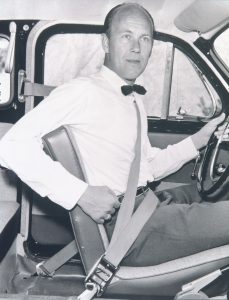 A very good example is Volvo. For 62 years, the company has been a leader in the field of car safety. That will never change because their vision is that no one should be killed or seriously injured in a Volvo car. That’s why every Volvo innovation, each of their offering on the market, is built around the idea of road safety – from the integration of airbags and the world-first side-impact airbags to a rear-facing child seat, to the top speed reduction to 180 km/h in 2020.
A very good example is Volvo. For 62 years, the company has been a leader in the field of car safety. That will never change because their vision is that no one should be killed or seriously injured in a Volvo car. That’s why every Volvo innovation, each of their offering on the market, is built around the idea of road safety – from the integration of airbags and the world-first side-impact airbags to a rear-facing child seat, to the top speed reduction to 180 km/h in 2020.
It all started in 1959, when Nils Bohlin, a Volvo engineer, invented the seat belt. Please note: Instead of keeping the patent as a unique competitive advantage (“With other car brands you will die, but not with us”), Volvo made the patent free and practically gave it to all of their competitors. And this is their winning move because, in this way, they proved to the whole world that road safety is not just a slogan with which they want to sell more, but a core value of the brand, which is far above commercial interest and profit.
2. Brand distribution
The brand idea needs to spread. However, how your business brings a change in people’s lives, it can not just be told. This is something that needs to be experienced. People should be given the opportunity to try and see for themselves. This is the exact opposite of advertising. Not saying but assaying. Not declaration but demonstration. Your product, point of sale and merchandising, your business processes, customer service, and help, brand values, and actions… All these are opportunities to impress people. The elements of your business become the brand assets and the medium for your message. So people will touch, see, and hear your brand storytelling in first-person. In the days of absolute marketing, the best advertising is in the first-person singular: I saw, I tried, I know.
We can call it “brand distribution”. Just like product distribution – for you to be commercially successful, your product must be available at all relevant points of sale. In order to have a well-known and accepted brand, it must be available at every relevant point of contact. Wherever the idea of your brand will be expressed with the greatest impact.
Nobody pays attention to the brands in the media. People pay attention to other things. We read the news, watch movies, laugh at memes, educate ourselves about our professional growth, or just plan for the next weekend. We live our lives. What is important to us are the real things. That’s why we notice the actions of the brands. Not their promises and advertisements, but the place they occupy in our lives. Making a brand part of our culture and habits is the best advertisement. This is the most effective consumer-connectivity tool that has ever existed. See how another absolute brand, Apple, builds the vibe of a company that unleashes your creativity:
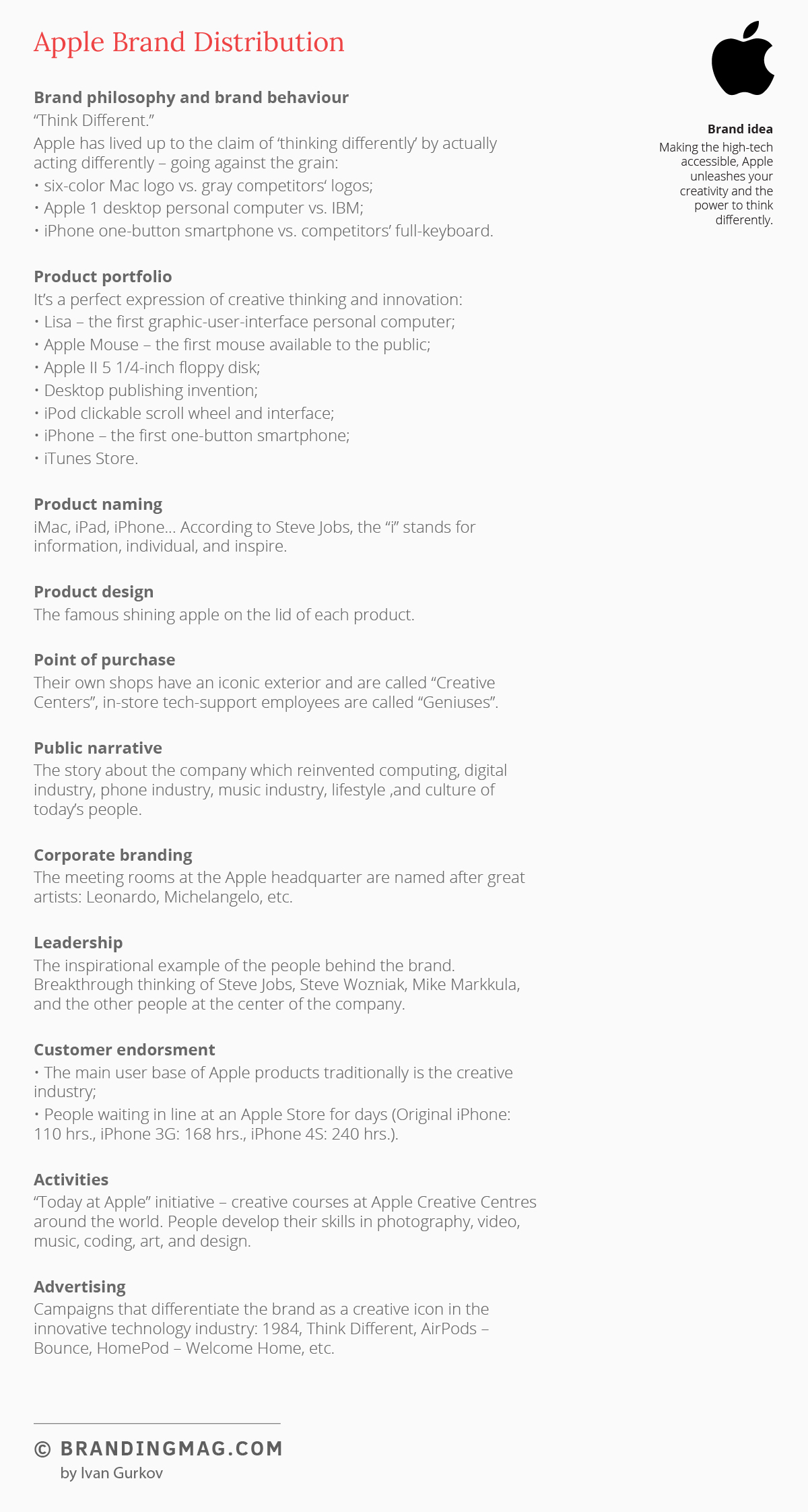
Finally, let’s go back to the brands we recognize, even without the brand name on the package. They are bigger than your logo and advertising. They just somehow have the power to be part of people’s general knowledge and culture.
Where does this power come from?
To find the answer, I suggest we relax and discuss something that, at first glance, has nothing to do with business cases and strategies. Have you ever seen a video with a man on a bench in London Park, singing as if no one could hear him? And soon, the whole park starts singing with him. This is how sharing works. An emotion that is passed from person to person and helps us feel good together. People know how to share – experiences, feelings, things in life. That’s why the people sitting on the grass in the park start singing with the man on the bench. The man shares his emotion and they resonate with the common vibe. Sharing unites us, it is part of our ability to integrate as a community.
The video is a great example of the power that absolute brands have always relied on. This is the main asset that all businesses will rely on, from now on. They cannot exist alone. We will all build new social and market relationships. Businesses and people together. And brands that manage to engage us because they give us the best of their product, stand up for our interests, or inspire us to live happier, will make out of us their community.
This is where it all begins.
—
As Brandingmag reached its 10th anniversary this year, we’re putting together an original series that envisions a perfect future for branding. Ten articles will explore ten different sides of branding, each one through the eyes of an expert on the subject. Join our celebration and stay tuned for the next installment in the “Branding’s Perfect 10” series.
Previously: Glenn Matchett on public relations
(Branding’s Perfect 10 – The PR Afterthought)
Next: Michael Duffy on packaging
(Branding’s Perfect 10 – Genuine, Credible, Trustworthy)
Cover image source: Duophenom

